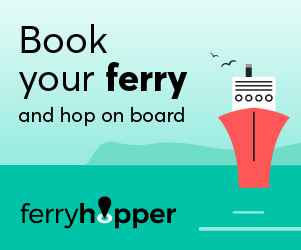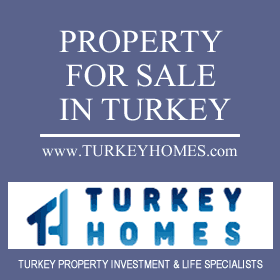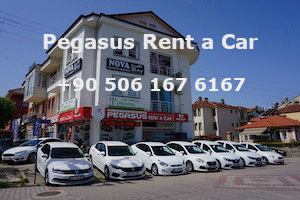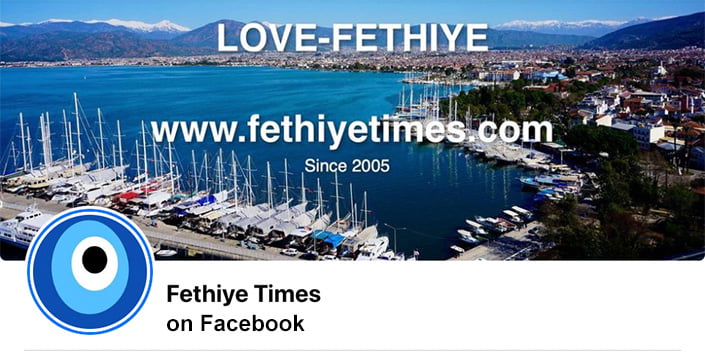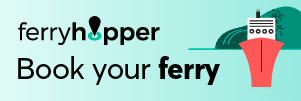Part Two of an adventure to Eastern Turkey
Please click on the link below if you missed Part One.
All aboard the Turistik Doğu Ekspresi to Kars
Written for Fethiye Times and with photographs by Mike Vickers and Jan Jones
Kars. The colder the weather, the warmer the people
Blimey, our room at the Güngören was hot! This was due to a radiator the size of a tennis court with the control valve apparently welded fully open. I couldn’t move it, however much I tried. As a result, we found the room stifling, although I’ve little doubt any Turkish guests would consider it barely warm. The only option was to open the window to allow in a breath of fresh air, but was this wise, Captain Mainwaring? This was Kars. In January. The outside temperature was an earlobe-numbing -17C. Our window looked out past yard-long, glistening, fang-like icicles. Pigeons puffed up to the size of beach balls were huddled on our balcony railing.
So, on our first night, unable to turn off the radiator and in an attempt to avert heat exhaustion, we actually cracked open the window, probably the first people ever to do so in January! The inflated pigeons perked up. Their cousins in Ankara station had texted them about the benefits of indoor living. Maybe this was their chance. Thankfully, the tiniest gap was amply sufficient to lower the temperature to a bearable level for a good night’s sleep.

Unlike Fethiye, where enquiries about gas central heating are, let’s face it, something of a rarity, Kars is fortunate enough to have its own natural gas mains supply via a spur leading in from the nearby South Caucasus Pipeline. This means boilers, steaming vents, proper radiators and radiant gas heaters in all their different forms. In other words, if you’re indoors, you’re warm. If you do venture outdoors, just make sure you’re wearing double the number of clothes you would normally wear, such as two pairs of socks, two pairs of trousers, two t-shirts, two pairs of gloves, you know the sort of thing. Even slim people end up looking distinctly spherical. Still, at least if you fall over on the ice you just bounce straight back up again.
I mention all this because it’s really rather important to factor in the temperature, whatever you’re doing. Go outside in the wrong clothing and you could be in a lot of trouble very quickly. Naturally, the good people of Kars are entirely acclimatized. Cars in Kars do not slow down for ice. No need – everyone drives on super grippy snow tyres. Pedestrians do not tip-toe over icy pavements. No need – everyone has proper boots.
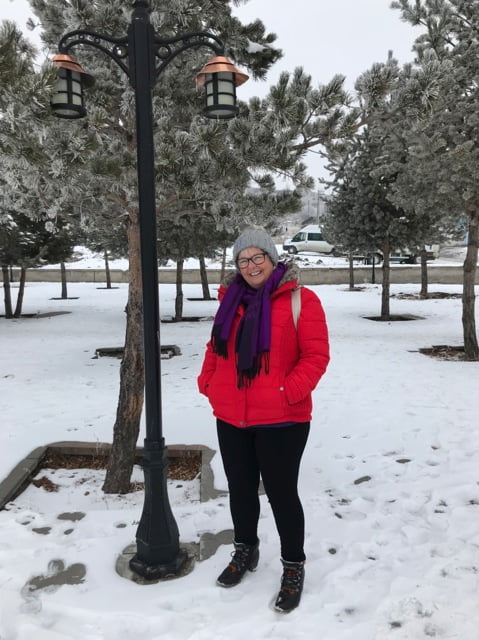
So, after a typical buffet tourist hotel breakfast, we ventured out to take in the lie of the land. Locals strode about nonchalantly texting while we warily negotiated surfaces that would have challenged any bobsleigh team. My word was it cold. I mean, properly cold. If you’re youngish, think winter 1982. If you’re of a more mature disposition, like me, 1963 comes to mind.
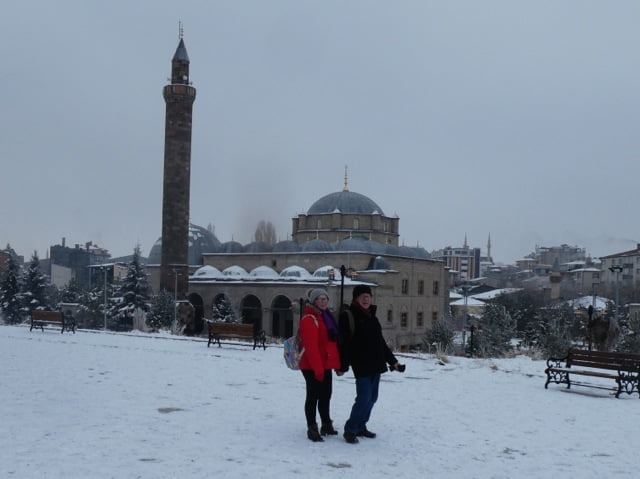
Modern Kars is laid out on the usual grid system, but the old town is much more interesting, with strong Armenian and Russian influences – unsurprising as the city only finally became Turkish in 1920. The castle dominates the city up on its crag, but the path was just a little too icy. We posed for photos outside the striking Church of the Apostles, built in 930 on a tetraconch layout, but I can imagine many of you glazing over at this point. What little interest I personally had in tetraconchal architecture had by now been replaced by an overwhelming compulsion for hot chocolate and something warm to eat.
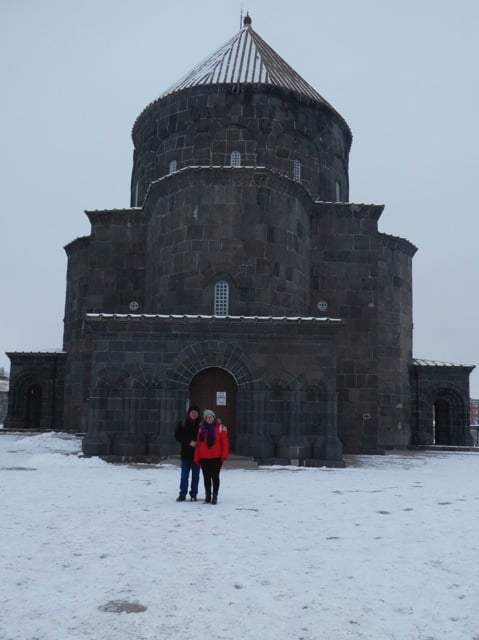
We finally fetched up at Sütlü Çardak, a bright and bustling restaurant deploying a winning combination of gas and electric heaters to produce a snug atmosphere. Lunch was excellent and the place hummed with youthful cool. It pains me to point out we didn’t qualify on either point, but no matter.
I swear I saw Torvill and Dean bolero their way gracefully into a Migros as we slithered back to the hotel.
Amber Travel had arranged a local guide for us and that evening, the very amiable Celil picked us up and took us to a dark and cosy traditional restaurant in town. Sorry, but none of us can remember its name – we were concentrating so hard on safely negotiating those Cresta Run pavements! This place specialized in live music and piti, a local delicacy of mutton and chickpeas on sauce-soaked flatbread, a real stick-to-your-ribs meal ideal for keeping those internal furnaces well stoked. Drinks flowed. I’m prepared to admit I may have engaged in some rakı-induced folk dancing at some stage of the evening.


The following day (window open again last night, optimistic pigeons edging ever closer, icicles another inch longer), Celil picked us up from the hotel in his minibus and we set off for the ruined city of Ani. The landscape outside Kars is essentially steppe, empty and undulating, with only the occasional deeply hibernating village to interrupt the desolate snowy grip of winter. It was extraordinarily beautiful.
The roads were, in general, very good indeed and kept clear by regular ploughing. There were virtually no trees and certainly no hedges of any kind, the long narrow fields defined only by lines of black stones poking up through the snow. We paused at a high point and there, above the distant clouds, rose the misty conical shadow of Mount Ararat, over 200km to the south. Now that was a moment to remember.
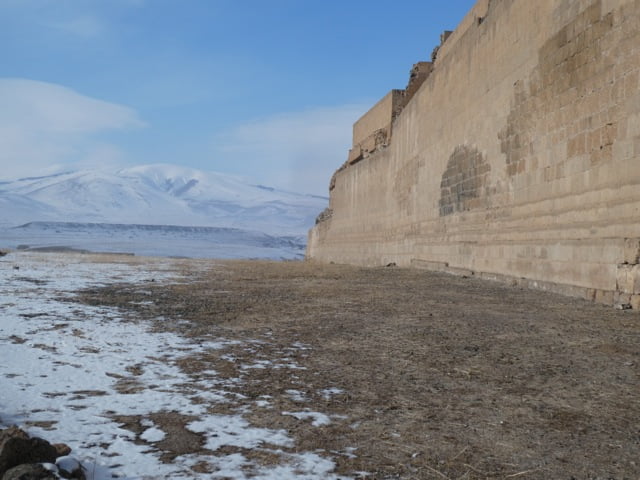
The sun came out as we eventually reached Ani, its massive walls springing suddenly from the frigid emptiness. Ani was once the capital of ancient Armenia but the city never really recovered from a devastating earthquake in the 14th century and was finally fully abandoned by the early 18th century. The site is enormous, but apart from sections of the city walls and some scattered monumental buildings, is now mostly a wilderness of rubble. As we walked around amongst the piles of stones, I saw some tracks in the snow.
‘What are these, Celil?’
‘The small ones are fox.’
‘And the big ones?’
‘Wolf.’
A sobering moment. I would not want to be stranded in Ani at night.
Celil proved a fount of knowledge. There isn’t much about Ani he doesn’t know. We took a circuitous route that took in ancient churches and the magnificent 11th-century cathedral, the largest remaining standing structure on the site. As we approached, a guide already inside was entertaining his customers by singing opera. He had a very fine voice, but it was a surreal moment as the music floated out of the ruins – he was singing what we all know as Just One Cornetto.

One major feature of Ani is the deep gorge of the Arpaçay River which defended much of the city. We were now at the very edge of eastern Turkey – the far bank is actually Armenia. There was once a bridge carrying the Silk Road across, but now only the ruined brick towers remain. It was so quiet there in the pale sunshine we could hear the river far below chuckling over pebbles. The border is currently closed and there are military bases and watchtowers on both sides.
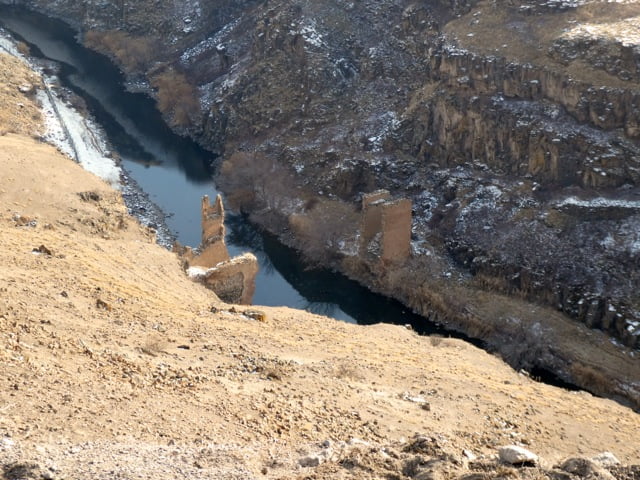
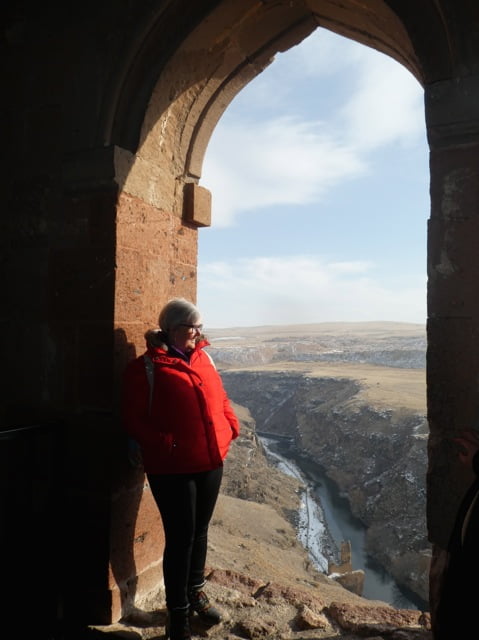
The visit to Ani was tremendous. The place is hauntingly impressive, its setting magnificent, with a backdrop of snowy peaks, yet we saw something just as wonderful on the journey back to Kars. Without warning, Celil pulled over on the deserted road and pointed. Perhaps a hundred yards away, trotting through the snow, were grey wolves, two on the right side of the road, one on the left. I thought about those tracks back in the ruins.
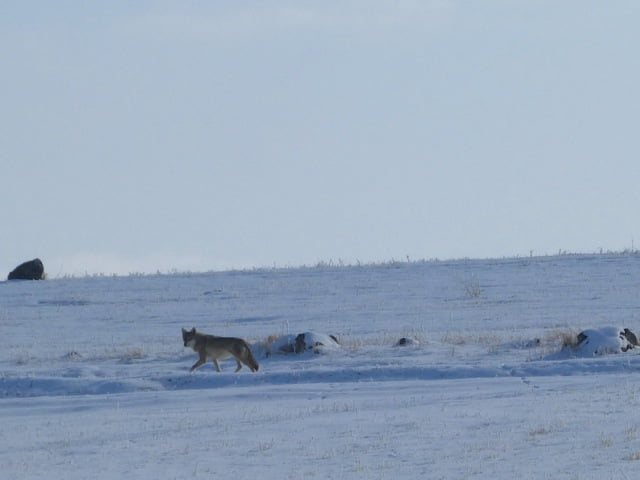

As we are citizens of Fethiye, we could not possibly visit Kars without visiting the Fethiye Camii, a former 19th-century Russian Orthodox Church now converted into a mosque. It’s lost its onion dome and tower, but gained two minarets. On the way back to the hotel, as we waited at the lights, Robin Cousins glided past before elegantly triple-salchowing his way into a nearby pharmacy.
We took our evening meal at Sütlü Çardak, knowing the place positively bristled with world-class heaters. The moment we finished eating, they pounced! Five students at the next table had politely waited but were now eager to know why we were in Kars. They expressed genuine astonishment on discovering we actually wanted to come to Kars. All were learning English and just could not pass up the chance of finding themselves sitting next to three English people, something of a rarity it seemed. They were studying the professions and all were delightful, charming, confident and lovely youngsters. It struck me at that moment – the colder the weather, the warmer the people.
Our third and final day in Kars was again spent with Celil, who arrived after breakfast in his trusty minibus to take us to Lake Çıldır. This visit was the original reason why we decided to come to Kars – Jan had always wanted to take a troika ride on a frozen lake and at last here was her chance. Çıldır lies at about the same height as the summit of Babadağ and so at this time of year was well and truly frozen, its ice crust at least two feet thick. Now, I know this sounds obvious, but the surface of a frozen lake is just about as flat as you can get and therefore offered absolutely no protection at all from the frigid wind whipping across the ice. I thought it was cold in Kars, but this was something else. No wonder the water was solid! An hour out there and I would be, too.
Fortunately, there was a hut out on the lake serving piping hot tea and mulled wine to counter the biting cold. Customers and troika drivers stood around a brazier warming themselves. A fire? On ice? Yes, the fire was on stilts to prevent the dangers of melting.
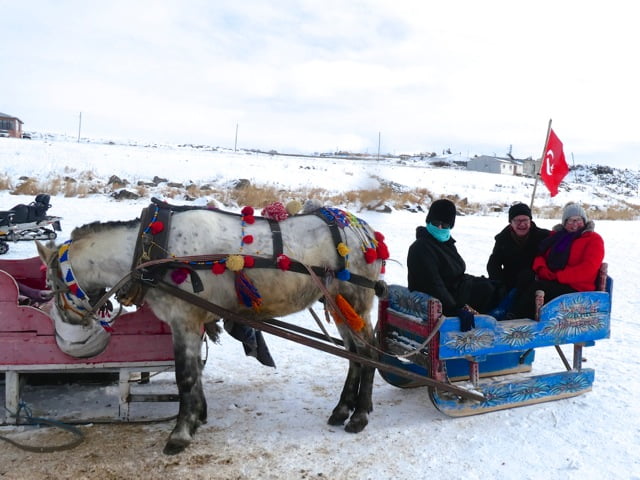
Our horse was called Champion and the only way his handler could stop him bolting straight back to his cosy stable was to stuff his face into a nosebag full of oats! Clever horse. Worked that one to his advantage, don’t you think? We three squeezed onto this tiny wooden sled while Celil sagely retired to the warmth of a nearby fish restaurant and off we went, trotting over the snow-covered ice. This was no marathon, thankfully, but a five-minute scamper that left us rosy-cheeked and cold-bottomed from the bare wooden seats – but it was truly, truly wonderful. On our return, Michelle joined Celil in the warm while Jan and I trotted back out to watch some ice fishing with two Turkish ladies, one of whom, astonishingly, was not wearing gloves.
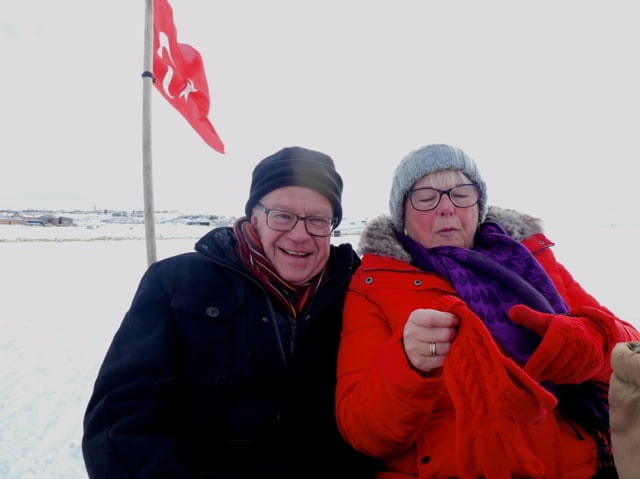
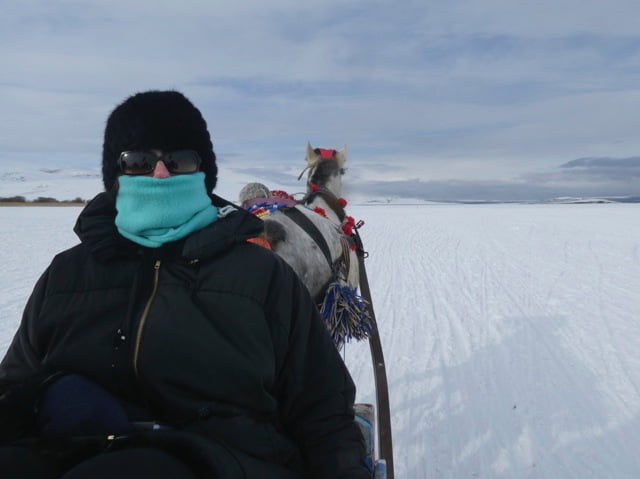

This guy wasn’t daft. This was ice fishing purely for the tourists. Two holes had been punched through the ice about 25 yards apart with the net strung between them. Our fisherman used a shovel to break the layer of ice that was readily skimming over the holes and pulled in his net. The gloveless Turkish lady helped. Her hands must have been perishing. Five or six fish were entangled in the mesh as the net emerged. The fisherman extricated one – which our companion promptly kissed – before returning the net down beneath the ice again – still loaded up with some pretty cheesed-off-looking fish. This meant the next group of tourists were guaranteed to see some caught in the net, a win-win situation for everyone. Except for the fish.
We joined Michelle and Celil in the fish restaurant. I had meatballs.
After lunch, Celil drove us further along the lake shore for quite a distance. Çıldır’s a big lake. We passed through some fairly remote villages, all hunkered down for the winter. Life was obviously very hard here. Many of the homes were simple black stone structures with turf roofs. These half-buried houses only had tiny roof windows, but each sported a flue that shimmered with heat from a soba. I thought of Ankara and its funky new skyscrapers. The contrast was humbling.

The wind got up on our way home, blowing sheets of powdery snow across the deserted roads. With an hour or so to spare, Celil gave us a short tour of the old town behind the castle. We British were responsible for many of the fortifications up there, in contrast to some ornate Russian riverside palaces, some of which have been converted into boutique hotels.
For our final evening meal, we chose the Kars Kazevi goose restaurant. Kaz, or goose, is a local delicacy and we each had a delicious bowl of shredded goose meat on a bed of rice. We slipped and slithered our way back to the hotel on slick pavements – Eddie the Eagle skied past testing his new salopettes and matching bobble hat – and Celil gave us a lift to the station to catch our train at 10 pm, seeing us off with a cheery wave. With a blast of the hooter, the train pulled out of Kars.
Once again, we were on the Turistik Doğu Ekspresi, this time heading west for Ankara.
A note on excursions
Prices (correct as of January 2020) are as follows:
Ani admission: 12 lira per person
Lake Çıldır troika ride: 15 lira per person
Lake Çıldır ice fishing: 35 lira per person
A special thank you
Celil Ersözoğlu was engaged by Amber Travel to act as our guide. We very much enjoyed our time with him. Not only is he an experienced and very knowledgeable English-speaking professional guide, but also easy-going, entertaining and cheerful company, with a ready smile and chuckle. If you ever find yourself in need of a guide in Kars, Celil can be contacted on 0532 226 3966 or at celilani@hotmail.com


